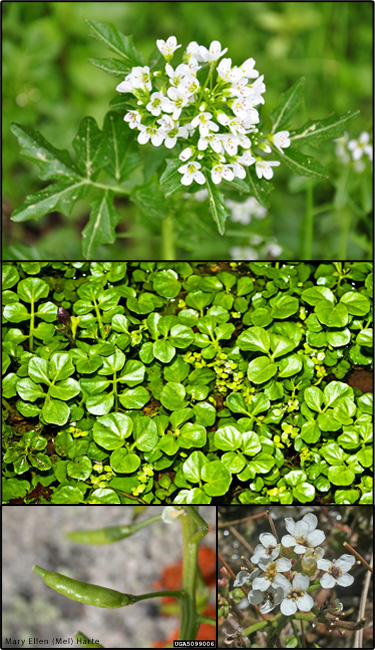Watercress (Nasturtium officinale)
 Synonyms: Nasturtium nasturtium-aquaticum, Nasturtium officinale var. siifolium, Rorippa nasturtium-aquaticum, Sisybrium nasturtium-aquaticum
Synonyms: Nasturtium nasturtium-aquaticum, Nasturtium officinale var. siifolium, Rorippa nasturtium-aquaticum, Sisybrium nasturtium-aquaticumDescription: One of the oldest known leaf vegetables consumed by humans. It was first reported in 1831 in southern New England by Yale University in New Haven, Connecticut. The first specimen was collected in 1841 in Niagra, New York.
Habit: Erect or spreading, perennial, 4-18 inches tall, emergent aquatic, sometimes evergreen, forming large, tangled wintergreen masses; stems spreading; rooting from the lower nodes.
Leaves: Alternate, odd-pinnate, petiolate, up to 15 cm. long, glabrous. Petiole partially clasping the stem. Leaflets 3 to 11, opposite to subopposite, sessile, oblique at the base, ovate-lanceolate, often emarginate at apex more than 2 cm long, more than 1 cm broad, entire to irregularly shallow crenate.
Stems: Up to or more than 60 cm long (tall), erect to ascending or creeping, from taproot and fibrous roots (often rooting at nodes), herbaceous, glabrous, fistulose.
Flowers: White in color, 4 petals, 0.5 in. wide, petals are 2 times longer than the sepals; inflorescence a cluster (raceme) of stalked flowers from the ends of the shoots; blooms May through October.
Fruit and seeds: Long, thin pod with coarse seeds in two rows.
Habitat: Native to Eurasia. Grows well in sun, streams, springs, cold water, in limy, sedimentary or gravelly soil.
Reproduction: By seed, though plant fragments can give rise to new plants locally. Both are dispersed by water.
Similar species: Onerow yellowcresss (Nasturtium microphyllum) is hard to distinguish from watercress. The most reliable difference is the reticulations on the seeds. Mature seeds are necessary for identification.
Monitoring and rapid response: Easily controlled by hand pulling. Depending on the populations, can be effectively controlled using any of several readily available general use herbicides such as glyphosate or triclopyr. Follow label and state requirements. Herbicide use is ineffective in flowing water where species often thrives. Credits: The information provided in this factsheet was gathered from the Invasive Plant Atlas of New England, Missouri Plants and the Robert W. Freckmann Herbarium.
Individual species images that appear with a number in a black box are courtesy of the Bugwood.org network (http://www.invasive.org).Individual photo author credits may not be included due to the small display size of the images and subsequent difficulty of reading the provided text. All other images appear courtesy of Google (http://images.google.com).
Common Name: | Watercress |
Scientific Name: | Nasturtium officinale |
Family: | Brassicaceae (Mustard) |
Duration: | Perennial |
Habit: | Herbs |
USDA Symbol: | NAOF |
